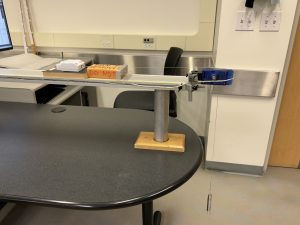Passive Forces Exercise 3
Exercise 3
3.1 In the rolling cart-track system, we can (and do!) ignore the effect of friction. For this exercise, you will use essentially the same set-up as in Exercise 2, except that the cart will be replaced by a sliding rectangular block so that the friction with the track is not negligible. You will also replace the 100 g cylinder with a spring.
Set up the block/pulley/spring system as shown below.

Use Capstone to observe the force, as measured by the force sensor, as you pull gently and with increasing force on the spring. (Try not to touch the table while you are doing the measurement as even the smallest vibrations can affect the outcome.)
a) Describe your observations as you are pulling on the spring.
b) Draw the free-body diagram for the block system. Which of the forces on your diagram is measured by the force sensor?
c) If the block remains at rest while you are pulling on it, what physical argument(s) can you make to deduce the force of friction acting on the block?
The frictional force acting between objects which are at rest with respect to one another is called the force of static friction. Notice that, like the normal force and tension, static friction is a passive force: in magnitude it can range anywhere between zero and some maximum value.
d) How is the coefficient of static friction defined? Use your measurements to estimate the coefficient for your block system.
3.2 In the previous exercise, you will have noticed that if the force on the block is large enough, the block slides. Once the block is in motion, kinetic friction will act on it. For this exercise it may be helpful to see the acceleration graph in Capstone.
Use the cord to pull the block so that it moves at a (more or less) constant speed (zero acceleration). This is a little tricky since you have to get the force and speed just right. Try watching the block move as you pull the block the length of the track. Then go back to the acceleration graph and see if you can find a piece of it over which the acceleration is roughly zero. Hint: It may be easier to achieve a constant velocity if you pull the string directly, not the spring.
a) Use your free-body diagram to write an expression for the force of kinetic friction acting on the block.
b) How is the coefficient of kinetic friction defined? Estimate the coefficient for your block system. How does this compare to the coefficient of static friction?
